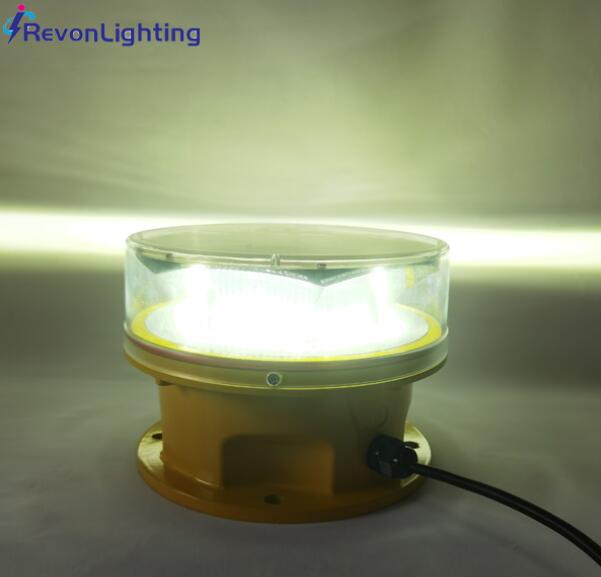White obstruction lights are a crucial component in the aviation industry, playing a vital role in marking tall structures to prevent collisions and ensure safe air navigation. These lights, mandated by various aviation authorities, are designed to be highly visible and provide consistent illumination under different conditions. This article explores the importance, types, regulatory requirements, and technological advancements associated with white obstruction lights.
The Importance of White Obstruction Lights
White obstruction lights are essential for several reasons, primarily related to safety and navigation:
Collision Prevention: These lights help pilots identify and avoid tall structures, such as communication towers, wind turbines, and high-rise buildings, especially during night flights or in poor visibility conditions. By marking these potential hazards, white obstruction lights significantly reduce the risk of mid-air collisions.
Enhanced Visibility: White lights are highly visible over long distances and in various weather conditions, making them ideal for daytime and twilight use. Their brightness and color make them easily distinguishable against natural backgrounds, such as clouds and landscapes.
Regulatory Compliance: Aviation authorities require the installation of obstruction lights on structures that pose potential hazards to aircraft. Compliance with these regulations ensures that structures are adequately marked, contributing to overall aviation safety and preventing legal penalties.
Operational Efficiency: For airports and airfields, white obstruction lights enhance operational efficiency by clearly marking obstructions, thereby aiding air traffic controllers and pilots in managing flight paths and takeoff and landing procedures.
Types of White Obstruction Lights
White obstruction lights come in several types, each designed for specific applications and regulatory requirements. The primary categories include:
Medium-Intensity Lights: These lights are typically used on structures of moderate height. They are visible during the day and twilight, switching to red lights at night in some cases. Medium-intensity white lights are often found on buildings, antennas, and wind turbines.

High-Intensity Lights: Designed for very tall structures, such as broadcast towers and skyscrapers, high-intensity white lights are extremely bright and visible from great distances. These lights are typically used continuously to ensure that tall structures are always visible to pilots.
Dual Lighting Systems: These systems combine white and red lights to provide visibility under various conditions. During the day, white lights are used due to their high visibility, while red lights are used at night to reduce glare and light pollution.
Strobe Lights: White strobe lights provide intermittent flashes of light, making them highly effective for marking tall structures. They are particularly useful in environments where continuous light might blend into the background, ensuring the structure remains conspicuous.
Regulatory Requirements
The implementation of white obstruction lights is governed by strict regulations set by aviation authorities to ensure consistency and safety. Key regulatory bodies and their guidelines include:
Federal Aviation Administration (FAA): In the United States, the FAA requires the marking and lighting of structures that exceed 200 feet in height or are near airports. The FAA Advisory Circular AC 70/7460-1L provides comprehensive guidelines on the types, colors, and placement of white obstruction lights.
International Civil Aviation Organization (ICAO): ICAO sets international standards for aviation safety, including the marking and lighting of obstacles. These standards are detailed in Annex 14 to the Convention on International Civil Aviation, ensuring a uniform approach to aviation lighting globally.
European Aviation Safety Agency (EASA): In Europe, EASA sets the standards for aviation safety, including obstruction lighting requirements. EASA’s regulations are aligned with ICAO standards to ensure international consistency.
Civil Aviation Authorities (CAA): Many countries have their own civil aviation authorities that enforce regulations similar to those of the FAA and ICAO. For instance, the UK CAA has specific guidelines for the lighting of tall structures to prevent hazards to air navigation.
Technological Advancements
Technological advancements have significantly enhanced the efficiency and effectiveness of white obstruction lights. Key innovations include:
LED Technology: Light-emitting diode (LED) lights have largely replaced traditional incandescent and fluorescent lights due to their longer lifespan, higher energy efficiency, and greater visibility. LEDs offer consistent illumination and are now the standard in most new installations.
Smart Lighting Systems: Integration with smart city infrastructure and Internet of Things (IoT) technology allows for real-time monitoring and maintenance of obstruction lights. These systems can automatically adjust light intensity based on ambient conditions and provide alerts when maintenance is needed.
| white obstruction light | MEDIUM LIGHT |
| HIGH LIGHT | 865 |
| 856 | 45 |
Solar-Powered Solutions: Advances in solar panel and battery technology have made solar-powered white obstruction lights more reliable and sustainable. These lights are particularly useful in remote areas where connecting to the power grid is impractical.
Dimming Capabilities: Modern white obstruction lights often include dimming capabilities to reduce light pollution and minimize the impact on nearby communities and wildlife. These lights can automatically adjust their brightness based on time of day and visibility conditions.
Challenges and Future Directions
While significant progress has been made, challenges remain in the implementation and maintenance of white obstruction lights:
Environmental Impact: White obstruction lights can contribute to light pollution, affecting local wildlife and ecosystems. Developing lighting solutions that minimize these impacts while maintaining safety standards is an ongoing challenge.
Maintenance and Durability: Ensuring the continuous operation of obstruction lights requires regular maintenance, which can be challenging for tall and remote structures. Advances in materials and design are helping to improve durability and reduce maintenance needs.
Cost and Accessibility: While LED and solar-powered lights offer long-term savings, the initial installation costs can be high. Efforts to reduce these costs and make advanced lighting technologies more accessible are crucial for wider adoption.
Conclusion
White obstruction lights are essential for ensuring the safety of air navigation by marking tall structures and preventing collisions. Through adherence to strict regulations and leveraging technological advancements, these lights continue to evolve, enhancing their effectiveness and efficiency. As the aviation industry grows and urban landscapes expand, the importance of reliable and sustainable white obstruction lighting will only increase, underscoring their role in protecting lives and property in the skies.